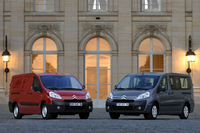The New CitroŽn JUMPY All-Purpose Vehicle
PARIS - November 14, 2006: CitroŽn has long been a key player on the light commercial vehicle (LCV) market. The constant match between CitroŽn’s range and market trends enabled the Marque to take 10.2% of the European market (26 countries) and the number-three spot in 2005. To give an idea of the importance of the LCV business for the Marque, 1 CitroŽn in five sold worldwide is an LCV and 1 LCV in 10 sold in Europe is a CitroŽn. Positioned between the Berlingo and the new Jumper, the new CitroŽn Jumpy is an excellent addition to the LCV range.
 |
The new Jumpy is packed with technological innovations and equipment dedicated to passenger and driver comfort and safety. The new vehicle offers many more combinations in terms of volume, payload and load length. This versatility is designed to appeal to increasingly demanding users.
The new Jumpy features:
• a bigger payload: the new version of the CitroŽn Jumpy has a much bigger payload, ranging from 1,000 kg to 1,200 kg, versus a range of 815 kg to 900 kg on the previous version.
 |
• a broad range of body styles and trims. The new version of Jumpy consists of two main families. The first comprises standard panel and window vans, as well as flatbed cabs for bodywork conversions. The second consists of combi vans for transporting people.
The combi van family is intended for small-business people whose work involves transporting people, and for consumers who are looking for a spacious, functional vehicle. The combi van family offers three trim and equipment levels and a five-seater and a nine-seater version. The top two trim levels for the combi van will be marketed under the name Atlante with a monogram on the vehicle, except in Germany and right-hand-drive countries. The interior of these versions features a carpeted fl oor and upholstered door panels.
• status-enhancing, dynamic styling. On the outside, the tough, modern design of the front end features a gutsy radiator grille and oversized bumper for extra protection against shocks. The rear has been designed for easy loading. At the same time, the layout of the driving position, soundproofing and ergonomic design, ensure that the cabin satisfies the requirements of the most demanding business users and consumers.
• a wide choice of engines. There is a choice of three diesel engines: the 1.6 HDi 90 (66 kW), the 2.0 HDi 120 (88 kW), and the 2.0 HDi 140 (100 kW) fitted with a particulate filter. All three engines are mated to manual gearboxes, with six speeds in the case of the last two. One petrol engine, the 143 bhp (103 kW) 2.0i, is offered, with a manual five-speed gearbox.
The new Jumpy can also be fitted with a wide array of options rarely seen on the LCV market, such as pneumatic rear suspension and automatic wipers and headlights.
With ABS and EBS fitted as standard, Jumpy also offers excellent road handling.
A COMPLETELY RESIZED INTERIOR
The new Jumpy range opens up new avenues in terms of styling options and available combinations. The broad choice on offer means more flexibility for buyers, which is a major innovation in relation to previous generations of this category of commercial vehicle.
The enhancements include:
• an increase in load length which now ranges from 226 cm to 256 cm. Buyers can further extend the load length by using the optional stowage tunnel, accessible from the rear of vans, which extends into the cabin right up to the driving position. The stowage tunnel, located at the top and in the centre of the partition between the cabin and the loading area, is especially handy for carrying very long goods or articles that require special protection.
• a significant increase in load volume, to a maximum of 7 m3;
• an increase in payload, which now ranges from 1,000 kg to 1,200 kg, versus a maximum of 900 kg previously;
• even easier access, both front and rear.
The new Jumpy has the driving position and manoeuverability of a saloon, and easy on-board access. Unlike many other LCVs, Jumpy has no step, offering easy access to the front seats. This is a valuable asset for business people who frequently climb in and out of their vehicles.
The loading sill of the new Jumpy is 56 cm off the ground with metal rear suspension. It can be lowered to 49 cm using the new pneumatic self-levelling rear suspension, available as an option. Pneumatic suspension has numerous advantages, including:
- an overall exterior height of less than 190 cm, while maintaining a load height of 140 cm. Whatever the type of suspension, this is a 14 cm improvement on the previous version. The low exterior height means Jumpy can be driven into car-parks without the driver having to use the suspension controls,
- a loading sill less than 50 cm off the ground and which can be lowered further 5 cm or raised 6 cm when the vehicle is stationary,
- constant vehicle height when in motion, regardless of load,
- greater suspension comfort, especially for passenger-carrying versions.



